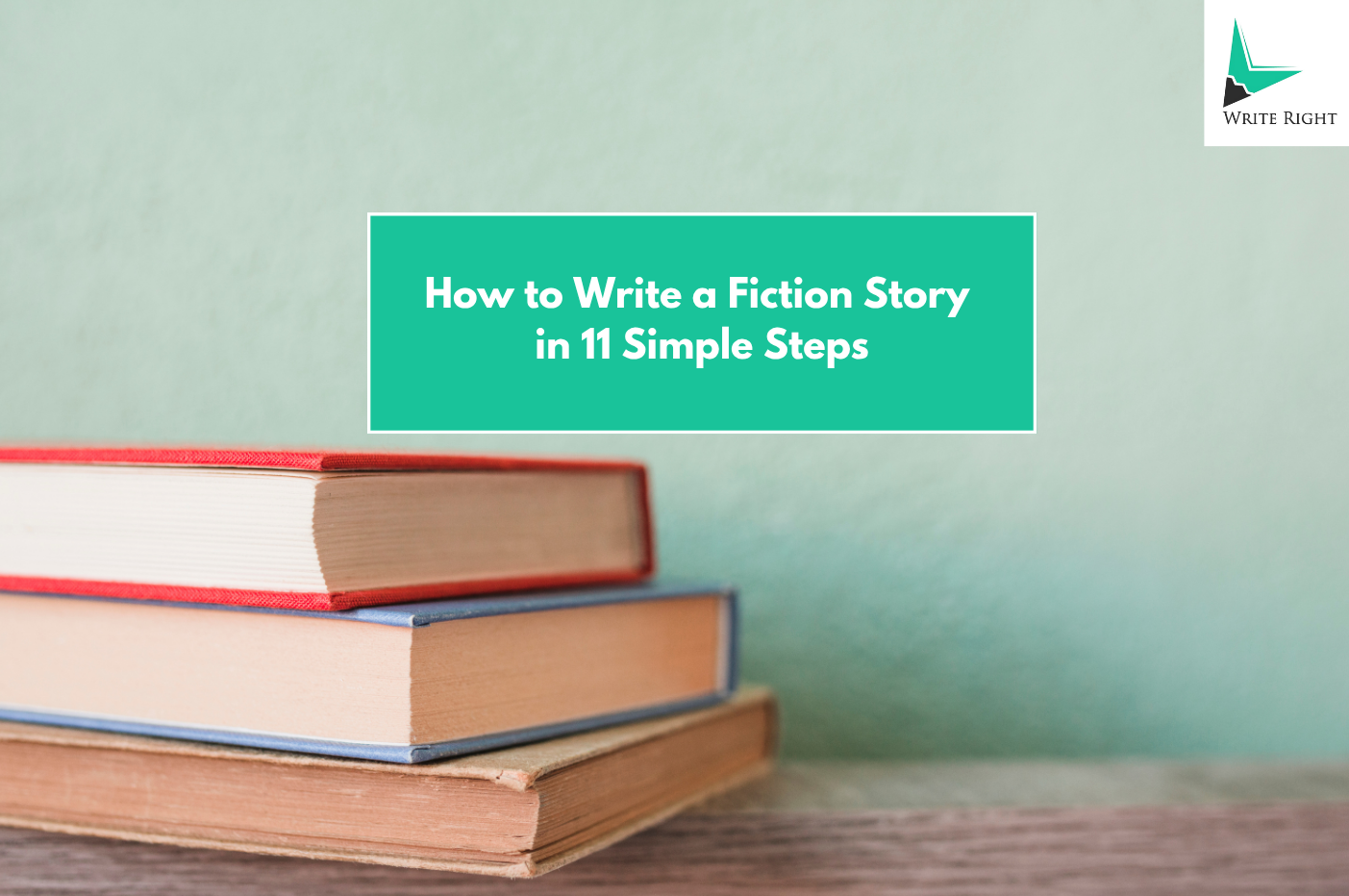If you’re wondering how to write a fiction story that actually captivates readers, you’re not alone.
It does not matter if you’re writing your very first paragraph or dreaming of publishing a full-length novel; fiction writing can feel both thrilling and confusing. How do you come up with an original idea? What makes a plot work? And how do bestselling authors make their stories so… unputdownable?
This beginner’s guide will walk you through every step of writing fiction, from idea generation to final edits. You’ll learn how to build believable characters, structure a compelling plot, avoid common pitfalls, and even prepare your story for publication.
Understanding Fiction Writing
Fiction writing is a creative form of storytelling rooted in imagination rather than fact. It’s where writers breathe life into imaginary worlds, unforgettable characters, and emotional journeys. Whether you’re interested in short stories or full-length novels, fiction allows you to explore the human condition, transport readers to new places, and create impactful narratives.
What is Fiction and Why It Matters
Fiction is a literary genre that encompasses made-up stories, though often grounded in universal truths. It’s a reflection of society, culture, relationships, and emotion. Writing fiction not only entertains but challenges perspectives and encourages empathy.
Types of Fiction
| Form | Word Count | Best Suited For |
|---|---|---|
| Flash Fiction | Under 1,000 words | Micro stories with a twist or emotional punch |
| Short Story | 1,000–7,500 words | Single event, theme, or character-driven plot |
| Novella | 20,000–40,000 words | Concise narratives with subplots |
| Novel | 50,000+ words | Complex plots, multiple characters, layered arcs |
Why Learn How to Write a Fiction Book?
Creative and Emotional Benefits
Fiction writing unlocks your imagination. It enhances:
-
Creative thinking: You invent entire worlds and rules.
-
Emotional intelligence: Crafting realistic characters requires empathy.
-
Communication skills: You express ideas, emotion, and intent clearly.
Writing fiction also provides catharsis. It’s a safe way to process emotions and share personal experiences through metaphors and narrative.
Fiction in Today’s Publishing World
Fiction books dominate bestseller lists in every format—paperbacks, eBooks, audiobooks. Platforms like Amazon KDP, Wattpad, and Medium have made publishing accessible for first-time authors. Genres like fantasy, mystery, romance, and science fiction enjoy massive fanbases, giving writers endless opportunities to connect with readers.
Step 1: Brainstorming Fiction Story Ideas
Finding Inspiration from Life and Media
Ideas are everywhere. Look around you:
-
Personal memories or family lore
-
News headlines or documentaries
-
A striking image or conversation
-
Books, movies, or myths with a twist
A useful approach is asking “what if?”
What if a world had no concept of lying?
What if someone received letters from their future self?
Using Prompts and Mind Maps
-
Try writing prompts from creative writing books or websites.
-
Use a mind map to explore a theme or character concept.
-
Keep a story journal or use apps like Evernote to log ideas.
Write Right offers expert writing services to help you transform your creative vision into a polished manuscript.
Step 2: Choosing the Right Genre
Choosing a genre shapes every element of your story—from tone and setting to language and plot devices.
Popular Fiction Genres and Themes
| Genre | Common Tropes or Features |
|---|---|
| Romance | Love triangle, forbidden love, second chance |
| Mystery | Whodunit, detective logic, red herrings |
| Thriller | Fast pacing, high stakes, unreliable narrator |
| Fantasy | Magic systems, mythical creatures, epic quests |
| Science Fiction | Time travel, AI, dystopian societies |
| Literary Fiction | Character-driven, philosophical, stylistic prose |
Aligning Genre with Audience
Ask:
-
Who are your readers?
-
What age group are you writing for?
-
What emotional experience do you want to deliver?
Study bestselling novels in your chosen genre to understand structure and audience expectations.
Step 3: Developing Your Plot
Plot is your story’s roadmap. Without a compelling plot, even the most interesting characters can fall flat.
Understanding Plot Arcs
Most successful fiction follows a recognizable arc:
-
Exposition – Introduce setting, tone, and characters.
-
Inciting Incident – An event that changes the status quo.
-
Rising Action – Challenges that build tension.
-
Climax – The turning point or peak conflict.
-
Falling Action – The fallout from the climax.
-
Resolution – Ties up loose ends and concludes the journey.
Conflict and Resolution
Conflict drives fiction. It can be:
-
Internal (emotional or moral struggles)
-
External (enemies, environment, or society)
Make sure your resolution satisfies the core conflict raised earlier in the story.
Got a story idea but unsure how to develop it? Partner with Write Right to turn rough concepts into full-fledged fiction projects with our expert storytelling team.
Step 4: Creating Memorable Characters
Protagonist and Antagonist Design
-
Protagonist: The character whose goals, flaws, and change arc define the story.
-
Antagonist: Can be a person, system, or internal flaw. They challenge the protagonist and shape the conflict.
Characters must have clear wants and needs, which sometimes oppose each other. This inner tension creates emotional resonance.
Character Arcs and Backstories
A strong character arc shows transformation:
-
From fear to courage
-
From selfishness to sacrifice
-
From ignorance to awareness
Use backstory sparingly to add depth—don’t info-dump. Reveal through behavior and dialogue.
Step 5: World-Building and Setting
How Setting Affects Your Story
The setting grounds your fiction in a believable space. Consider:
-
Social norms and laws
-
Weather and geography
-
Time period
-
Political systems
A well-constructed setting enhances immersion and mood.
Tools for Effective World-Building
-
Sketch a map for geography
-
Develop a calendar or timeline
-
Create character cultures, histories, or languages
-
Use sensory details (sight, smell, touch)
Step 6: Structuring Your Novel or Story
Three-Act Structure (Universal Framework)
-
Act 1 (Beginning): Set the stage and introduce the problem.
-
Act 2 (Middle): Escalate stakes, complicate goals.
-
Act 3 (End): Resolve the story with impact.
Chapter and Scene Planning
Use scene cards to plot:
-
Purpose of each scene
-
Character involved
-
Conflict or tension
-
Result or change
Let Write Right help you structure a compelling narrative that keeps readers on the edge of their seats.
Step 7: Writing the First Draft
Overcoming Perfectionism
The first draft isn’t meant to be perfect—it’s meant to exist. Focus on completing the story rather than polishing it line by line.
“You can’t edit a blank page.” – Nora Roberts
Setting Writing Goals
-
Daily word count goals (500–1,000 words)
-
Timed writing sprints (Pomodoro technique)
-
Track progress using apps like Dabble or 4theWords
Step 8: Revising and Editing
Self-Editing for Fiction Writers
-
Trim redundancy
-
Improve scene transitions
-
Eliminate clichés and vague descriptors
-
Strengthen dialogue and pacing
The Role of Beta Readers
Choose trusted readers who:
-
Enjoy your genre
-
Will give honest, constructive feedback
-
Can pinpoint inconsistencies or weak scenes
Step 9: Finalizing Your Manuscript
Polishing Language and Flow
Read your manuscript out loud. This helps catch:
-
Awkward phrasing
-
Repetition
-
Unnatural dialogue
Use tools like:
-
Grammarly for grammar checks
-
Hemingway Editor for clarity and tone
Checking for Plot Holes
Create a timeline or checklist of plot points. Ensure:
-
Each subplot resolves
-
Character actions align with motives
-
The ending reflects the story’s themes
Step 10: Publishing Your Fiction Book
Traditional vs. Self-Publishing
| Model | Benefits | Challenges |
|---|---|---|
| Traditional | Prestige, marketing support | Long process, requires agent |
| Self-Publishing | Full control, quicker release | You handle all aspects yourself |
Introduction to Amazon KDP
Amazon’s Kindle Direct Publishing (KDP) lets you:
-
Upload and format your manuscript
-
Set pricing and royalties
-
Reach millions of readers instantly
Step 11: Marketing Your Fiction Story
Building an Author Brand
Your author brand is your promise to readers. Define your:
-
Niche (e.g., dark fantasy, clean romance)
-
Voice (witty, dark, lyrical)
-
Visual style (colors, fonts, cover designs)
Using Social Media and Book Launch Strategies
-
Schedule a pre-launch campaign
-
Collaborate with bloggers or bookstagrammers
-
Offer ARC copies for early reviews
-
Run giveaways or contests
Tools and Resources for Writing Fiction
| Tool | Use |
|---|---|
| Scrivener | Outlining and manuscript organization |
| Grammarly | Grammar and clarity enhancement |
| Plottr | Visual plotting and timeline management |
| Canva | Creating promotional graphics and mockups |
Recommended Resources:
-
Save the Cat! Writes a Novel by Jessica Brody
-
On Writing by Stephen King
-
Reddit’s r/writing and Scribophile for community support
Common Mistakes in Fiction Writing (and How to Avoid Them)
Frequent Errors
-
Over-explaining or “telling” instead of “showing”
-
Flat, one-dimensional characters
-
Weak or predictable conflict
-
Info-dumping instead of organic world-building
Solutions
-
Study genre-specific books
-
Get critiques from other writers
-
Read your work aloud
-
Revise with intention and patience
Why Choose Write Right for Professional Writing Help
If you’re passionate about fiction but unsure how to execute your ideas or finish your manuscript, Write Right can support you at every stage.
How Write Right Empowers Fiction Writers
-
Professional content consultation and development
-
Manuscript editing and polishing
-
Storyboarding and character development
-
Assistance with publishing and marketing strategies
Whether you’re starting from scratch or refining a draft, Write Right helps transform raw ideas into finished, publish-ready fiction books, backed by industry professionals and creative storytellers.
Conclusion: Start Writing Your Fiction Story Today
You now have everything you need to begin your fiction writing journey. From crafting powerful characters and compelling plots to structuring scenes and finalizing your manuscript, every step matters. Don’t wait for the perfect moment—start now, write consistently, and revise with confidence.
And when you’re ready for expert input, Write Right offers the tools, experience, and creative insight to help you bring your story to life.





